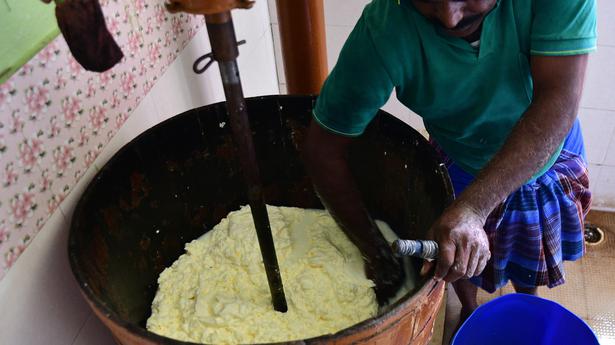
Uthukuli: The buttery town
The Hindu
Slightly sour taste and lack of gloss mark the butter
The smell of butter wafts in the air as one drives through the Kunnathur Road at Uthukuli in Tiruppur district. This stretch is home to around a dozen dairy units that produce the famed Uthukuli butter, which continues to be in demand across and even outside the State for over six decades.
At the Avarampalayam Sarvodaya Sangh dairy unit, established in 1989 under the Khadi and Village Industries Commission, the work begins early in the morning. The unit’s manager, P. Rasu, says dairy farmers from the surrounding villages such as Pappampalayam, Vengalapalayam and Chengapalli in Tiruppur district and Thippampalayam and Kodumanal villages in Erode district supply cream to the dairy units in Uthukuli. The farmers use cream separators in their villages to separate the cream from the milk. About 10 kg of cream yields eight kg of butter.
So, what makes the ‘Uthukuli butter’ special?
The uniqueness lies in the buffalo milk and its fodder, Mr. Rasu says. “Uthukuli being an arid region, the buffaloes are mostly fed with solathattai (sorghum stalks), kolukattai pul (a type of drought-resistant grass) and cotton seed. This makes its milk rich in fat content than the regular cow’s milk,” he notes. “There will be around one kg of cream for 10 litres of buffalo milk.”
Uthukuli butter is characterised by its slightly sour taste and lack of gloss, compared with the other commercially available butter. It will remain unspoiled for nearly a month if kept in room temperature without any contact with water, Mr. Rasu asserts. It is even sold to dealers in Maharashtra, Karnataka, Kerala and Puducherry.
K. Subramaniam, proprietor, K.S. Dairy Farm, established in 1973, says Uthukuli butter has been in vogue at least since the 1950s. “As the British mostly consumed bread and butter, techniques to manufacture butter prevalent in Europe were introduced during their rule,” he says. The nature of milk from the buffaloes contributed to this butter’s unique taste, which fuelled its demand.
However, all is not well as the dairy units face an existential crisis, with the number of units dwindling, a reduction in buffalo-rearing and lack of major innovations. “Around 20 years ago, there were over 30 units in the Uthukuli taluk. Now, there are only 12 units,” Mr. Rasu says.













